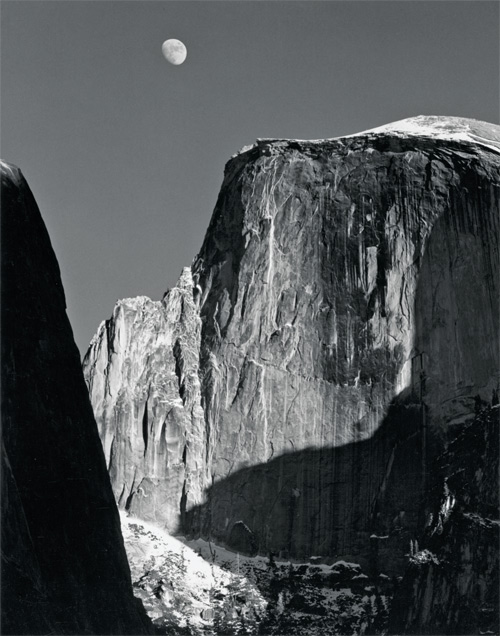
In the 1930s and ’40s, when photography pioneer Ansel Adams was at the height of his creative powers, his magnificent images of California landscapes drew attention both to the art of photography and the importance of nature conservation.
Adams lived on the Monterey Peninsula from 1962 to 1984, and captured black and white images of California’s most beautiful places, including Yosemite and the Big Sur coast. Through October, the Monterey Museum of Art (MMA) La Mirada presents a rare chance to see 72 of Adams’ most iconic photographs, hand-chosen by the artist before his death in 1984. His daughter, Anne Adams Helms, has offered this “Portrait of America” exhibit to MMA to “experience the essence of some of the greatest natural environments ever captured by a true innovator,” says Museum Executive Director E. Michael Whittington. The Monterey museum is the only West Coast gallery to display this special “Museum Set.”
MMA curator Marcelle Polednik explained, “We have a good relationship with his [Ansel Adams’] family, and we wanted to commemorate Ansel’s great art. We saw that the museum set was on a worldwide tour, and we haven’t had an exhibit dedicated to Ansel Adams in a long time, so we saw this as a perfect opportunity.”
Ansel Easton Adams was born near San Francisco in 1902 and experienced the San Francisco Earthquake as a child—in fact, he broke his nose after one of the aftershocks knocked him down! He grew up on the coast near the Golden Gate Bridge and from his description in his autobiography, the beach and ocean scenery impressed him at an early age. He also writes of his boredom in school and his great desire to be outside, playing in the fog and sand. In his early teen years, Adams began seriously studying classical music and became an accomplished pianist.
Were it not for his Aunt Mary giving him a book called “In the Heart of the Sierras,” Adams might have photographed a different part of California and not given Yosemite the widespread recognition it deserved. But in 1916, Adams insisted the family take its vacation to Yosemite, and his life was changed at the sight of the national park’s grandeur. On this trip, he also received his first camera. The environmental photographer was born!
The beautiful mountains and forest also cured his many childhood illnesses. In 1919, he joined John Muir’s Sierra Club and began covering Yosemite in extended hikes. This new love of travel inspired more involvement with the Sierra Club and the National Park Service in the 1930s, to preserve natural beauty statewide. After some protest from painters and sculptors at the California School of Fine Arts who felt this new photography was “not an art,” he started a Department of Photography at the school in San Francisco in 1946. With increasing acclaim as an artist and teacher, Adams started photography workshops in Yosemite Park in 1955, which he kept until 1982, when he moved these workshops to the Carmel area.
Meanwhile, in the early 1960s, Adams felt the need to move out of San Francisco, and chose a property in the Carmel Highlands, with impressive views of the coast and Point Lobos, a base Adams would live and work from until his death in 1984. During this period, Adams founded an art group called The Friends of Photography with local artists Brett Weston, Wynn Bullock, Jim Alinder and others. This group and its students (including John Sexton and Cole Weston) put Carmel on the national map for photographic arts, although Adams continued to travel from his new Carmel home to the Sierras, New Mexico and other beautiful places to shoot and refine his photography.
In the mid 1970s, the Center for Creative Photography was born from the earlier Friends group, where Adams archived many of his prints and negatives. He was very concerned about the future use of his images, and began to limit the prints he made, primarily because of time constraints after their popularity. Major museums still requested his prints, and from these needs he began to create “museum sets” such as the one on display at MMA, for audiences to share. “Works of art, literature or music have little value or human benefit if held available only to the few,” he wrote in his autobiography. “Comprehending the natural world is, in itself, an act of creation and should be universally shared.”
The crisp black and white images,with unique compositions, are still in high demand. In 1981, a print of “Moonrise, Hernandez, New Mexico” set a record price of $71,500. In 2006, the print sold for $609,600. Just a few months ago, a new record was set, also for an Adams’ print: “Clearing Winter Storm, Yosemite National Park” sold for $722,500 (this image can be seen in MMA’s current exhibit).
America’s most famous photographer, Ansel Adams, once wrote in a book introduction, “I find it impossible to ‘verbalize’ on the expressive content of the photograph—mine or anyone else’s. If the image cannot stand on its own, so to speak, no patina of words will enhance it.” Visit the Monterey Museum of Art La Mirada before October to experience his images firsthand.
For more information on Ansel Adams’ “Portrait of America,” call the Monterey Museum of Art, 831/372-5477. 720 Via Mirada, Monterey. The photography exhibit is on display through Oct. 3.